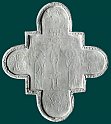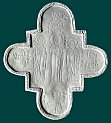Cross of Jerusalem


The so-called cross of Jerusalem is - as two other small boxes in London and Munich - a reliquary. The 12th century case is not designed to be kept in a special location but could be carried by its owner. That fact sets it apart from other examples. It has been made as a protective cover for relics in shape of a Greek cross. Inside, it shows the engraved representation of the crucifixion of Christ, flanked by Mary and John and surrounded by four archangels in the foil-ends. But who is represented on the outside? Interpretations differ on this. It has been thought that it might show Emperor Constantine I. and his mother Helen because of their efforts on behalf of Holy Places in the Holy Land, including the represented place of crucifixion. Beyond that, it is well-known that (cross) relics were frequently taken to the Occident by pilgrims from the Holy Land. But it must also be stated that there are no other facts that back up this theory. What is more, the meaning of the barely legible inscriptions seems to exclude this theory. Intensive efforts by philologists have identified the names Peter and Paul in the horizontal foil-ends and the name Eulalia for the right of the three central figures. Therefore, we have to conclude that it remains impossible to determine exactly either the origins or even the exact content of the art piece.




